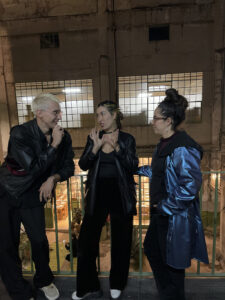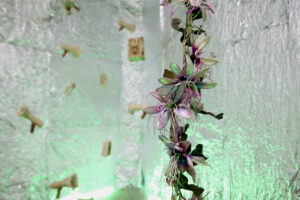Travesias - #colaboracion #ayarkut #residencias #travesias
Reading time: 8 minutes

24.11.2023
Terremoto talks to Andrea Bustillos, Ayarkut’s Curatorial Director about their collaboration, plans, common grounds and possible futures.
 Travesías is a new artistic residency program for Latin American artists conceived by Terremoto and made in collaboration with Ayarkut. Divided into yearly iterations, each volume will explore a territory along the continent and will delve into a specific topic of research. This will allow us to map and explore extensively decentralized territories in the Americas, giving the opportunity for Latin American/Latinx cultural practitioners to travel, dialogue, write and research with fully-funded programs. In this interview, Terremoto talks to Andrea Bustillos, Ayarkut’s Curatorial Director about their collaboration, plans, common grounds and possible futures.
Travesías is a new artistic residency program for Latin American artists conceived by Terremoto and made in collaboration with Ayarkut. Divided into yearly iterations, each volume will explore a territory along the continent and will delve into a specific topic of research. This will allow us to map and explore extensively decentralized territories in the Americas, giving the opportunity for Latin American/Latinx cultural practitioners to travel, dialogue, write and research with fully-funded programs. In this interview, Terremoto talks to Andrea Bustillos, Ayarkut’s Curatorial Director about their collaboration, plans, common grounds and possible futures.
Terremoto: We are thrilled to announce our collaboration with Ayarkut. Their support has been fundamental to transform the printed magazine into a new residency program that aims to propitiate that Latin American artists travel, explore and engage with urgent conversations within our geopolitical and affective realities, allowing spaces for collaboration, writing and reflection.
I would like to start off this conversation by asking what Ayarkut is –how do you operate as an organization, what are your goals, why did you decide to come to México and why are you interested in the format of the residency as a site of critical thinking?
Ayarkut: Ayarkut is a cultural organization focused on supporting artists and the artistic ecosystem in different parts of the world. Our mission is to foster critical dialogue, inspire action, and drive meaningful impact in society. By supporting artists we enable them to create work that resonates with communities, stimulates reflection, and promotes social cohesion.
Something important to acknowledge is that Ayarkut is an organization powered by InDrive, the second biggest ride-hailing company worldwide. When InDrive invited Ayarkut to be part of their InVision Department, it opened up exciting opportunities for us to expand internationally and think on a global scale. Our decision to start operations in Mexico came from a combination of both passion and pragmatism. On one hand, it was a heartfelt choice driven by Nadja Zinovskaya, Ayarkut’s founder, who has a deep affection for Mexico City. On the other hand, the recognition of the growth and professionalization that Mexico has experienced in the past years has given solidness to the art ecosystem, while it is still a place full of potential to do new things.
Right now we are working as a foundation, directly funding projects to be initiated, implemented, grown or established as references of social engaged projects which support artists and/or communities through their work. Our primary objective is to empower artists, acknowledging their capacity to be catalysts for social change. We recognize their ability to raise awareness, challenge conventions, and ignite conversations on vital societal issues.
As we have come to see, artistic residencies represent a milestone in the artists’ career. There’s a lot to discuss about the importance they have, but I think there is a genuine need in the artistic process for time and space to focus on a specific project, whether it’s for research, production or a technical aspect. The main goal of a residency is to take time (without financial stress, or everyday distractions) to delve into a process. At the same time, most residencies offer the connivance with other artists which may always bring different light to one’s own process. Furthermore, the accompaniment of curators, mentors or any other agent “guiding” or supervising the process is also part of these practical enrichment. Of course there is also a factor of visibility, growing connections and networking that comes out of these programs.
T: We believe there are a lot of common grounds between Terremoto and Ayarkut as organizations. One important shared value is we both seek to promote a global south perspective, giving a voice to Latin American practitioners, challenging hegemonic western views. Can you tell us more on how you envision igniting conversations from this side of the ocean?
A: Before Ayarkut started growing globally, the first decision was to work from and for Latin America and the global south. Some of the projects we are supporting right now have a strong commitment in the decentralization of the arts. For instance, in February 2023 we had the Ayarkut Talks and the theme was “Alternative Economy Models in Contemporary Art”. Most of the guests’ lectures came from the global south, such as Farid Rakun as part of ruangrupa from Indonesia; Maria Paola Malavasi from Costa Rica as part of Teor/Ética; among many other Mexican curators, artists and projects. But beyond their location, all of them were approaching the topics questioning the hegemonic understanding of economy and giving space to wider conceptions and possibilities. Some other projects as NODOS and MArCE (Museo de Arte contemporáneo de Ecatepec) share this idea not only of decentralizing the art practices, but also questioning the models and forms of contemporary art. In this sense, I believe the “global south thinking” it’s not only about geography, but it is a way of thinking that questions the established order, and approaches critically to certain epistemologies and the forms that have imposed certain ways of thinking. By acknowledging these processes of systematically thinking we can open space for new ways of thinking, knowing and working.
 So, part of our mission is to listen and support these other voices and perspectives. Even though there are already some important organizations in Mexico funding artistic projects, there is an opportunity to create a groundbreaking association that aims to nurture the local ecosystem and continue growing from and for the Global South. I recognize how this has been a relevant topic for many years, explored by projects such as Terremoto or Red conceptualismos del Sur, who have been working on Latin American perspectives engaging with critical thinking, affections and ethics.
So, part of our mission is to listen and support these other voices and perspectives. Even though there are already some important organizations in Mexico funding artistic projects, there is an opportunity to create a groundbreaking association that aims to nurture the local ecosystem and continue growing from and for the Global South. I recognize how this has been a relevant topic for many years, explored by projects such as Terremoto or Red conceptualismos del Sur, who have been working on Latin American perspectives engaging with critical thinking, affections and ethics.
T: Travesías Terremoto will be divided into volumes, each edition will focus on a specific territory and a topic of research entangled with the landscape we will be working on. For our first volume we will be embarking on a trip to the Sonoran desert to bring together Latin American artistic and scientific practices to explore space exploration, planetary imagination and the possibilities of the cosmos in the face of a bleak future on Earth. The project consists of thinking of the desert as if it was another planet due to its exoplanetary landscape to collectively reflect on utopian strategies of world creation, and space exploration under an anti-patriarchal, anti-colonial and anti-racist gaze.
What is the most exciting part of this project for you? Why support and engage in these radical imagination strategies?
A: You just said it: the radical imagination. When I learned about the project my first thought was this was something really different in several ways. First of all, it’s not a production residency, which it’s already a political stance, but it is not a research residency either, in a sense that it is not aimed for artists to delve in their own personal practice or long term research. Rather, it is going to be a residency where the artists are gonna be placed in a very specific landscape that will provoke new perceptions, perspectives, ideas, and hopefully open space for new possibilities. Sometimes we feel there’s no way out of the bleak future we have in front of us, with so many difficult fronts to fight for. Therefore, there is an urge to escape reality, not in a numbing way, but rather in an imaginative one. I feel imagination and creativity are places where we can still find hope and peace of mind. I am talking about a shift on how we perceive the world, how we learn and how we apprehend the reality around us.
Another interesting point about the way the residency is planned has to do with the bodily experience, taking the artists to the desert will definitely impact them in a physical way, and I think it’s interesting to pay attention to the knowledge and information that comes from the body, and later on to think rationally about it. Last but not least, I am very excited to see what comes out from the gathering of artists with diverse scientific agents. I have always thought that art is a tool to understand life, just as science is. They take different paths but both of them aim to expand the knowledge and understanding of ourselves and our environment, and in this sense they share a common ground. So, I am very excited to learn more about this interdisciplinary dialogue.
T: Just to finish, we can talk further about our collaboration. Travesías is a whole new project possible thanks to the commitment of Ayarkut not only to our first edition but also to the editions to come. How do you think this collaboration can grow, expand and nurture in the future?

A: If I had to choose just one word I would say learn. We feel excited to learn about the outcomes of the residencies as well as the process of management, coordination and production of such an ambitious project. Creating creative projects includes being creative during the process and I think there is going to be a lot of potential to rethink the art system, the relevance of residencies as spaces of dialogue, and the importance of giving support to both artists and artistic initiatives.
T: Thank you so much Andrea! We are thrilled to commence these journeys around the continent hand in hand with an institution like Ayarkut. As you know we kick off these residencies in northern Mexico, but next editions will take place nomadically in the Caribbean, Colombia, Brazil and other territories we would like to explore under new topics of research and urgent conversations. We would like to finish this conversation by saying that welcome to Mexico in this new chapter of Ayarkut and we hope to ignite conversations together as challenging as exciting for the contemporary art ecosystem.
Comments
There are no coments available.